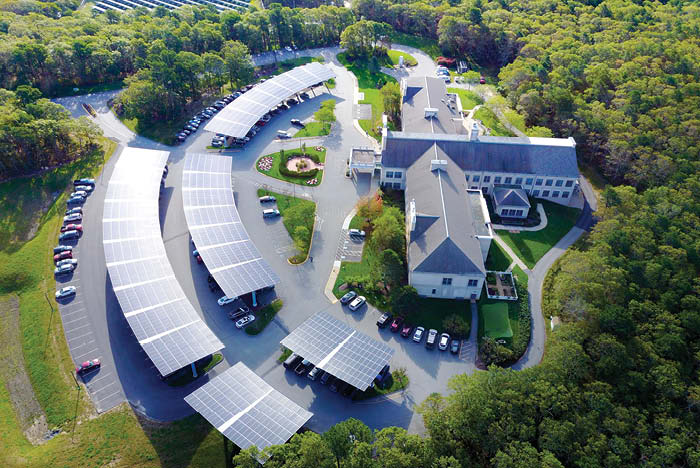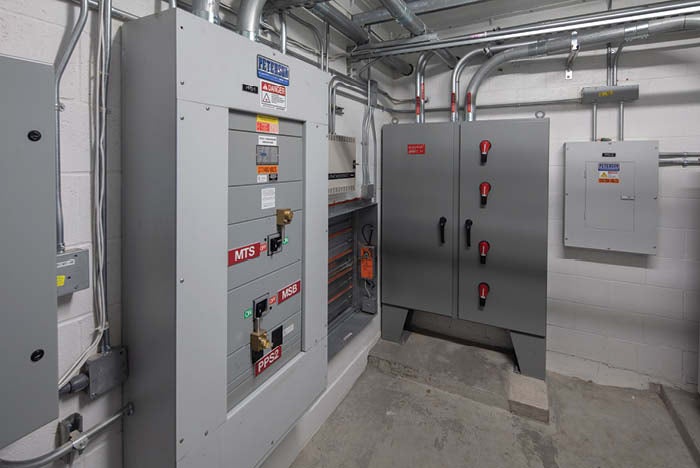Designing health care microgrids

In 2018, the California Energy Commission funded a project at Kaiser Permanente’s Richmond Medical Center that has demonstrated the ability of distributed storage to reduce the demand for electricity powered by fossil fuels and the additional resiliency renewable energy microgrids provide.
Image courtesy of Kaiser Permanente
The microgrid — a collection of energy assets that work together with intelligent controls — has long been part of the energy systems of health care facilities in the form of diesel generators.
But, while health care facilities have always had some form of on-site energy generation, rapidly emerging new technologies and the growing desire for reliable power and cleaner energy sources have put a renewed focus on more sophisticated microgrids, particularly those using renewable energy components.
There is no one path to creating a microgrid, and the process can be complex, but the long-term benefits and rewards are substantial. As the microgrid landscape evolves, embracing advanced microgrid designs also signals a break from the ways that health care facilities have traditionally managed their energy systems.
Health care facilities managers need information and tools to better understand microgrids and to guide them through the design and planning process.
Health care requirements
The Department of Energy’s Microgrid Exchange Group defines a microgrid as “a group of interconnected loads and distributed energy resources within clearly defined electrical boundaries that acts as a single controllable entity with respect to the grid. A microgrid can connect and disconnect from the grid to enable it to operate in both grid-connected or island mode.”
This definition describes the following three main components of microgrids:
- A microgrid is made up of a collection of energy generation, transformation, and storage assets and technologies that work together. These energy resources can be fuel cells, solar panels, wind turbines, batteries, energy storage systems, natural gas generators, diesel generators, other emerging alternate energy technologies or public utilities — each of which has specific advantages and disadvantages.
- The electrical boundaries of the microgrid are identifiable and distinct from the external utility.
- The microgrid has a controller that allows it to manage the bundle of generation assets with intelligence. In other words, the microgrid can be programmed to think about the loads it is serving, assess the availability of energy sources and determine the best combination depending on cost, weather, reliability, emissions or other important inputs.
However, health care facilities are distinct from other occupancies, and this affects both their power needs and the systems that operate and supply power.
“The primary difference is patient care as opposed to just ensuring that power is adequate so people can safely get out of the building,” says Krista McDonald Biason, PE, vice president and senior electrical project engineer at HGA Architects and Engineers. “Many inpatient health care facilities are defend-in-place facilities, and they cannot lose power for an extended duration of time. With the electrical design of health care facilities, there is a primary power source and then an independent, backup power source. If you lose either that original primary power source or the pathway, you still maintain the backup independent source and path for maintaining power.”
The recognition of a particular type of microgrid — the health care microgrid — and its specific code requirements is a recent development. The 2021 edition of the National Fire Protection Association’s NFPA 99, Health Care Facilities Code, includes reference to health care microgrids and performance standards for serving essential energy systems.
The definition of health care microgrids, while similar to that of traditional microgrids, is more complex, with additional measures related to boundaries, controllability and reliability. This inclusion of health care microgrids in NFPA 99 marks the first step in the development of regulations that will begin to mainstream health care microgrids in the future. NFPA 70®, National Electrical Code®, is also moving toward the adoption of microgrids for use as emergency power sources.
Resources
“A health care microgrid is essentially a microgrid on steroids,” says Chad Beebe, AIA, CHFM, CFPS, CBO, FASHE, deputy executive director at the American Society for Health Care Engineering (ASHE). “While there have been systems in the past that may meet the loose definition of a traditional microgrid, the intelligence and access to multiple new sources that we did not have before adds a considerable amount of complexity to the system.
“The ultimate goal with health care microgrids is no single point of failure. With today’s technology and the design practice for traditional microgrids, there could be several potential single points of failure,” Beebe says. “It is important that designers with specific knowledge and expertise with the NFPA 99 health care microgrid criteria be involved in the design of such systems.”
Opportunities and challenges
“Microgrid-related technology is advancing rapidly in ways that make things possible today that weren’t possible five or 10 years ago, both from an engineering perspective and a financial perspective,” says Walt Vernon, PE, FASHE, principal and chief executive officer at Mazzetti. “Related to this are evolving energy and pollution markets. As these new technologies emerge, they are disrupting the old ways of thinking about how energy needs to be produced for the good of society.”
Jonathan Flannery, MHSA, FASHE, FACHE, senior associate director of advocacy at ASHE, believes health care microgrids are the future of health care facilities, particularly because of the additional resiliency that facilities can attain by having the systems in place.
“A health care microgrid could provide 100% electricity to an entire campus,” he says. “If there was a major outage in the area, the facility would not have to worry about the support system because it would have electricity. The outpatient clinics would not shut down, surgeries would not need to stop and patient care would continue. Continuation of operations is a real driver of this type of system.”
Health care facilities are especially vulnerable to more frequent and severe natural disasters as well as compromised or overtaxed utility grids that can shut down operations and impact patient care and safety. Microgrids can address these issues through the sustainability benefits that a system with a diverse array of power sources offers.
“There’s a growing recognition of the reality of climate change, and the contribution of health care to that issue,” Vernon says. “Traditional on-site generation sources also produce pollutants that are harmful in the local microclimate area. So there is an environmental imperative to move toward better power generation sources and methods.”
In addition to the resiliency and sustainability benefits, health care microgrids can improve energy efficiency and lower energy costs, Beebe says. “In health care, energy, particularly electrical energy, usually accounts for about 50% of a facility’s utilities. With health care microgrids, you can reduce energy costs and also sell or trade power. There are huge opportunities to offset the initial costs.”
Traditional microgrids depend solely on diesel generators, which have simple, replicable designs that on their own do not involve much variability. However, the inherent adaptability of microgrids and the various renewable energy source options are also major advantages. At the same time, renewable energy microgrids are generally more complicated, require significant investments in design and planning, and depend on knowledgeable experts.
“If I’m trying to design a microgrid, I might be next to a river, so I need to think about hydroelectric,” Vernon says. “If I’m at the middle of Arizona and I want solar, that’s a different microgrid. If I’m in Michigan and I want to use biomass, that’s a different design. So, every microgrid is going to be different and, therefore, it’s harder to design, harder to procure, harder to compare the costs. Everything about it is more complicated.”
The costs involved with microgrids are also a major consideration. “You have to be honest about the financial challenges,” Biason says. “Where do you get the funding? Who is going to pay for that much photovoltaics or alternate energy sources? Where are you going to put them? Do you have to buy more land? Do you have to change the rating and construction of your facility to accommodate the equipment? How are you going to actually interconnect things? What is the long-term gain from this system? These are all important questions to ask.”
Even with the potential cost savings, microgrids may be less of a funding priority for health care organizations. “Infrastructure-type projects like health care microgrids can involve large amounts of capital dollars, and acquiring funding can be a struggle,” Flannery says. “A new MRI machine or a new patient service can mean dollars next year, whereas a health care microgrid is going to save money but not make [money].”
Still, health care microgrids can be funded many different ways, and facilities owners should explore the range of innovative funding strategies, says Vernon, the electrical engineer for two microgrid projects at Kaiser Permanente hospitals in California. Kaiser Permanente implemented these renewable energy microgrids through grants and a power purchase agreement, a combination of funding strategies that required no capital funding from Kaiser Permanente.
The specific needs of health care facilities are an added hurdle in developing microgrids for health care. “Where health care microgrids start to become more challenging is when you need to address the essential systems requirements,” Biason says. “Just because you have a solar panel doesn’t necessarily mean that it has been listed or rated to be utilized as an emergency power source or an essential systems power source. The codes are starting to become more inclusive for alternate energy sources, but there is a lag between code requirements, adoption by approval agencies and manufacturing of products.”
The evolving NFPA codes as well as the Centers for Medicare & Medicaid Services’ regulatory requirements add another layer of complexity to the process. “Health care microgrids are a perfect example of how health care facilities could be utilizing the latest technology and running facilities more efficiently and safely and with better continuity,” Beebe says. “But facilities face challenges because of code issues. ASHE will continue to advocate that newer editions of the codes be adopted on a more frequent basis to reduce the burden on health care facilities.”
A complex undertaking
FROM TOP: Renewable components that may be incorporated into microgrids include solar arrays, such as this one at Mass General Brigham affiliate Spaulding Rehabilitation Hospital in Sandwich, Mass.; and fuel cell installations, such as this one at a California health care facility.


Top Image courtesy of Dennis Villanueva of MGB engineering and utilities; bottom Image by Bernard Andre’ Photography
Developing a health care microgrid is a complex undertaking that requires time and resources. “It is a blend of engineering, economics and regulation — and you cannot do it successfully without all three,” Vernon says. “There’s also no one-size-fits-all solution because every state is different in terms of its codes and energy markets. So a building owner needs to find somebody who can help them understand their particular needs and the regulatory and economic framework and then suggest a palette of different opportunities.”
Biason agrees that the right group of experts is essential in successfully designing and implementing a health care microgrid. “If you’re jumping into this for the first time and doing a microgrid in health care, you really need a team of people with their own skill sets who represent different facets of the project,” she says. “A design engineer, a code expert, industry trade experts and equipment suppliers — each of them brings individual expertise and you need to pull them together to get the best results.”
Health care facilities can also leverage existing assets, adds Jason D’Antona, PE, LEED AP, director of engineering and utilities at Mass General Brigham in Sommerville, Mass. “Many health care organizations are financially stressed now, especially because of COVID-19, and coming up with an economic case for a health care microgrid will be somewhat difficult,” he says. “But most hospitals have existing on-site renewables or fuel generation, and integrating those into a health care microgrid is not a great leap.” Mass General Brigham’s engineering and utilities department is currently studying the application of its existing renewable generation resources into microgrids at multiple health care facilities.
Health facilities managers can take other smaller steps toward developing a type of quasi-health care microgrid. The incorporation of noncritical facilities into a microgrid model is one way to start the process. These facilities are in contrast to critical facilities — such as operating rooms — where life-threatening loads are required to be maintained. For example, a medical office building that operates on a 9-to-5 schedule could be deemed noncritical and rely on the microgrid as its primary source of power.
Health facilities managers can also empower themselves by taking advantage of tools that explain microgrids and how the array of options apply in particular situations. The Distributed Energy Resources Customer Adoption Model (DER-CAM) is a free software program available from Lawrence Berkeley National Laboratory (https://dercam.lbl.gov ). DER-CAM uses optimization to determine the potential value of distributed energy resource assets across a set of value streams. Facilities managers or the consultants they work with can use it to determine the ideal portfolio, capacity and operations specifications for a particular site.
“DER-CAM is a useful tool for building operators because it allows them to take an early-stage concept, or even just the motivation to explore distributed energy resources, and quickly develop a feasible design and quantify potential economic, environmental and operational benefits,” says Nicholas DeForest, senior scientific engineering associate at Lawrence Berkeley National Laboratory. “It requires users to plug in information to characterize their specific site, which DER technologies they are interested in and what their system objectives are. The model does the rest.”
Moving forward
Microgrids in health care are new and still evolving, both in terms of technology and regulations. Even with these uncertainties, health care facilities managers should feel comfortable moving forward with health care microgrid projects. Most importantly, they need to be aware of the trends, codes, regulations and issues, and work with designers who understand the health care environment to help them take full advantage of the available opportunities.
“People should not be afraid of health care microgrids, nor should they be unaware of the issues,” Vernon says. “What we need are pioneers — people willing to take on and manage some risk because they see the pot of gold at the end of the rainbow. With the right partners, they can make good decisions and end up with systems that provide resilient, economic and environmental benefits.”
Camille N.Y. Fink is a freelance writer based in Oak Park, Ill.


